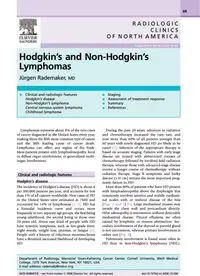
04 - Radiol Clin N Am 2007 - Hodgkin's and Non-Hodgkin's Lymphomas PDF
Preview 04 - Radiol Clin N Am 2007 - Hodgkin's and Non-Hodgkin's Lymphomas
Hodgkin’s and Non-Hodgkin’s Lymphomas Ju¨rgen Rademaker, MD Lymphomas represent about 4% of the new cases of cancer diagnosed in the United States every year, making them the fifth most common type of cancer and the fifth leading cause of cancer death. Lymphoma can affect any region of the body. Most patients present with lymphadenopathy, focal or diffuse organ involvement, or generalized multi- organ involvement. Clinical and radiologic features Hodgkin’s disease The incidence of Hodgkin’s disease (HD) is about 4 per 100,000 persons per year, and accounts for less than 1% of all cancers worldwide. New cases of HD in the United States were estimated at 7880 and accounted for 14% of lymphomas [1–3]. HD has a bimodal incidence curve and occurs more frequently in two separate age groups, the first being young adulthood, the second being in those over 50 years old. About one third of people with HD have systemic symptoms, such as low-grade fever, night sweats, weight loss, pruritus, or fatigue [4]. People with a history of infectious mononucleosis have a threefold increased likelihood of developing HD. During the past 20 years, advances in radiation and chemotherapy increased the cure rate, and now more than 80% of all patients younger than 60 years with newly diagnosed HD are likely to be cured [5]. Selection of the appropriate therapy is based on accurate staging. Patients with early stage disease are treated with abbreviated courses of chemotherapy followed by involved field radiation therapy, whereas those with advanced-stage disease receive a longer course of chemotherapy without radiation therapy. Stage B symptoms and bulky disease (>10 cm) remain the most important prog- nostic factors in HD. More than 80% of patients who have HD present with lymphadenopathy above the diaphragm that commonly involves anterior and middle mediasti- nal nodes with or without disease of the hila (Figs. 1 and 2) [6]. Large mediastinal masses may invade the chest wall and pericardium directly. Hilar adenopathy is uncommon without detectable mediastinal disease. Pleural effusions are often caused by lymphatic or venous obstruction. Sec- ondary involvement of the thyroid or parotid gland is not uncommon, whereas primary involvement is rather rare (Fig. 3). Pulmonary involvement is found more often in HD than in non-Hodgkin’s lymphoma (NHL). R A D I O L O G I C C L I N I C S O F N O R T H A M E R I C A Radiol Clin N Am 45 (2007) 69–83 Department of Radiology, Memorial Sloan-Kettering Cancer Center, Cornell University, Weill Medical College, 1275 York Avenue, New York, NY 10021, USA E-mail address:
